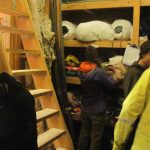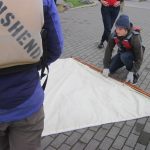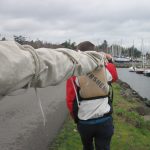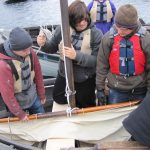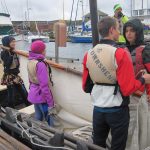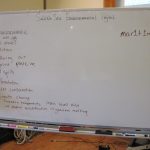We started the day with more getting to know each other– Nancy had us write down a hobby, our favorite book and our favorite food on a piece of paper. Then we shuffled them around and had to find the person who wrote those things.
After getting into our new partnerships, we headed outside to check the weather. We observed winds over 20 knots and two foot wind waves coming from the Southeast. Back in the classroom, we also saw that NOAA had posted a Small Craft Advisory for Admiralty Inlet. The weather had definitely exceeded what is allowed by our COI and we all agreed that it wouldn’t be all that fun to be out in a longboat.
Adverse weather didn’t mean that we couldn’t learn more about sailing, though. After donning our life jackets and adding a few more layers, we headed outside to review parts of the sail using the sail parts puzzle. We each had a sail part and used the clues to find the locations on the sail.
As mariners, we know that windy conditions mean reefing sails. Reefing is a way to make the sail smaller by rolling up the foot of the sail and tying it up with the reef nettles. On a longboat sail we also re-lead the tack and the sheets. After refreshing our sail parts, we headed down to the longboat to practice reefing our sails in windy and realistic conditions (but still safely tied to the dock).
After successfully setting, striking and furling our sails it was time to take our chilly fingers back into the classroom. We had a lovely snack (thanks PT Food Co-Op!) and Anna shared her Salish Sea Report on Orcas and Chinook Salmon. Connor also shared his completed report from last week on the Rough Piddock clam.
We spent the last portion of class doing some work towards our environmental project. Looking at a map of the Salish Sea, we discussed the major influences of the Salish Sea ecosystem– the Fraser river watershed and the ebb and flood of tide through the Strait of Juan de Fuca.
In partners, we chose an environmental problem we are concerned about and looked at it more closely. Who or what does it affect? Is it a short timeline or long timeline problem? Why do we care about it? What else do we need to know about it?
As a reflection, we shared something we learned about and something that makes us feel hopeful about environmental problems. We learned about how plastic in the ocean is carried by currents, how toxics move up the food chain, how many oil spills occur in our area, deforestation and the contribution of trees to our environment, the impact of greenhouse gasses to our rivers and salmon, and Ocean Acidification and its impact to ocean food chains.
We are hopeful about all of the people working to solve these problems, the technological advances and discoveries being made, improving safety regulations, new alternatives to plastic and wood products, and the ways we see people in our community making choices to help the environment.
We will be using our environmental concerns to develop our Bravo Team service project- stay tuned as we decide how we want to make a difference!
